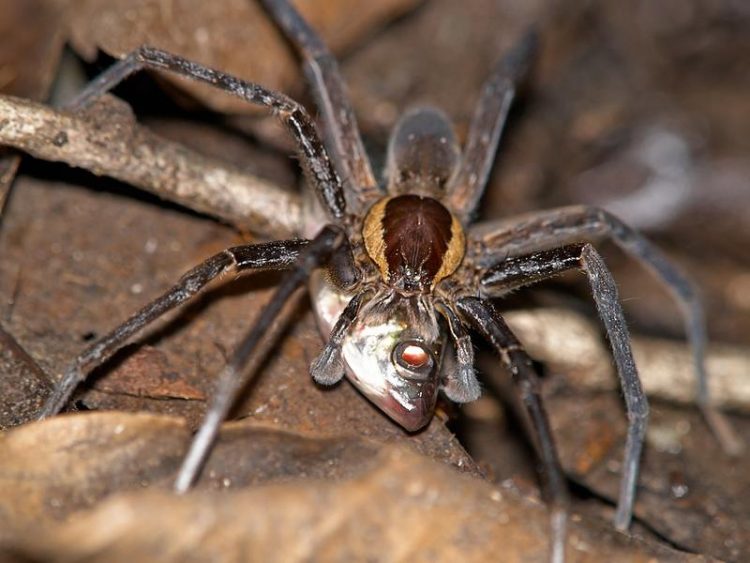Fish-eating spiders discovered in all parts of the world

Adult male of Ancylometes sp. (possibly Ancylometes rufus) caught characiform (Cyphocharax sp.) near Samona Lodge, Cuyabeno Wildlife Reserve, Ecuador Ed Germain, Sydney, Australia (Martin Nyffeler & Bradley Pusey (2014) Fish Predation by Semi-Aquatic Spiders: A Global Pattern. PLOS ONE http://dx.plos.org/10.1371/journal.pone.0099459)
Although viewed by ecologists as the classical predators of insects, researchers have become increasingly aware that spiders are not exclusively insectivorous. Certain larger-sized species supplement their diet by occasionally catching small fish. This shows a new study by zoologist and spider expert, Martin Nyffeler from the University of Basel, Switzerland and Bradley Pusey from the University of Western Australia. The researchers gathered and documented numerous incidents of spiders preying fish from all around the world.
Fish as a diet supplement
According to their systematic review, spiders from as many as five families have been observed preying on small fish in the wild and three more families contain species that catch fish under laboratory conditions. These so called semi-aquatic spiders typically dwell at the fringes of shallow freshwater streams, ponds or swamps.
These spiders, some of which are capable of swimming, diving and walking on the water surface, have powerful neurotoxins and enzymes that enable them to kill and digest fish that often exceed them in size and weight. “The finding of such a large diversity of spiders engaging in fish predation is novel. Our evidence suggests that fish might be an occasional prey item of substantial nutritional importance”, says Martin Nyffeler.
Based on this study, naturally occurring fish predation by spiders has been reported from all continents with the exception of Antarctica. Most incidents have been documented in North America, especially in the wetlands of Florida, where semi-aquatic spiders have often been witnessed catching and eating small freshwater fish such as mosquitofish. In order to catch its prey, the spider will typically anchor its hind legs to a stone or a plant, with its front legs resting on the surface of the water, ready to ambush. The fish will then be dragged to a dry place before the feeding process can begin which usually lasts several hours.
Original source
Martin Nyffeler & Bradley Pusey (2014) Fish Predation by Semi-Aquatic Spiders: A Global Pattern. PLOS ONE http://dx.plos.org/10.1371/journal.pone.0099459
Further information
PD Dr. Martin Nyffeler, Department of Environmental Sciences, University of Basel, phone: +41 61 702 07 03, email: martin.nyffeler@unibas.ch
Media Contact
Weitere Informationen:
http://www.unibas.chAlle Nachrichten aus der Kategorie: Biowissenschaften Chemie
Der innovations-report bietet im Bereich der "Life Sciences" Berichte und Artikel über Anwendungen und wissenschaftliche Erkenntnisse der modernen Biologie, der Chemie und der Humanmedizin.
Unter anderem finden Sie Wissenswertes aus den Teilbereichen: Bakteriologie, Biochemie, Bionik, Bioinformatik, Biophysik, Biotechnologie, Genetik, Geobotanik, Humanbiologie, Meeresbiologie, Mikrobiologie, Molekularbiologie, Zellbiologie, Zoologie, Bioanorganische Chemie, Mikrochemie und Umweltchemie.
Neueste Beiträge

Diamantstaub leuchtet hell in Magnetresonanztomographie
Mögliche Alternative zum weit verbreiteten Kontrastmittel Gadolinium. Eine unerwartete Entdeckung machte eine Wissenschaftlerin des Max-Planck-Instituts für Intelligente Systeme in Stuttgart: Nanometerkleine Diamantpartikel, die eigentlich für einen ganz anderen Zweck bestimmt…

Neue Spule für 7-Tesla MRT | Kopf und Hals gleichzeitig darstellen
Die Magnetresonanztomographie (MRT) ermöglicht detaillierte Einblicke in den Körper. Vor allem die Ultrahochfeld-Bildgebung mit Magnetfeldstärken von 7 Tesla und höher macht feinste anatomische Strukturen und funktionelle Prozesse sichtbar. Doch alleine…

Hybrid-Energiespeichersystem für moderne Energienetze
Projekt HyFlow: Leistungsfähiges, nachhaltiges und kostengünstiges Hybrid-Energiespeichersystem für moderne Energienetze. In drei Jahren Forschungsarbeit hat das Konsortium des EU-Projekts HyFlow ein extrem leistungsfähiges, nachhaltiges und kostengünstiges Hybrid-Energiespeichersystem entwickelt, das einen…





















